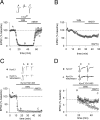Mechanisms for synapse specificity during striatal long-term depression
- PMID: 17494712
- PMCID: PMC6672378
- DOI: 10.1523/JNEUROSCI.0018-07.2007
Mechanisms for synapse specificity during striatal long-term depression
Abstract
Endocannabinoid (eCB)-mediated forms of long-term synaptic plasticity occur in several brain regions, but much remains unknown about their basic properties and underlying mechanisms. Here, we present evidence that eCB-mediated long-term depression (eCB-LTD) at excitatory synapses on medium spiny neurons in the striatum requires presynaptic activity coincident with CB1 receptor activation. This dual requirement for CB1 activation and presynaptic activity is a mechanism by which eCB-LTD may be made synapse specific.
Figures




Similar articles
-
Disruption of endocannabinoid release and striatal long-term depression by postsynaptic blockade of endocannabinoid membrane transport.J Neurosci. 2004 Feb 18;24(7):1673-9. doi: 10.1523/JNEUROSCI.5214-03.2004. J Neurosci. 2004. PMID: 14973237 Free PMC article.
-
The role of protein synthesis in striatal long-term depression.J Neurosci. 2006 Nov 15;26(46):11811-20. doi: 10.1523/JNEUROSCI.3196-06.2006. J Neurosci. 2006. PMID: 17108154 Free PMC article.
-
Endocannabinoid-dependent plasticity at GABAergic and glutamatergic synapses in the striatum is regulated by synaptic activity.Eur J Neurosci. 2009 Jan;29(1):32-41. doi: 10.1111/j.1460-9568.2008.06551.x. Eur J Neurosci. 2009. PMID: 19120438 Free PMC article.
-
Endocannabinoid signaling and synaptic plasticity in the brain.Crit Rev Neurobiol. 2006;18(1-2):113-24. doi: 10.1615/critrevneurobiol.v18.i1-2.120. Crit Rev Neurobiol. 2006. PMID: 17725514 Review.
-
Endocannabinoids in striatal plasticity.Parkinsonism Relat Disord. 2012 Jan;18 Suppl 1(Suppl 1):S132-4. doi: 10.1016/S1353-8020(11)70041-4. Parkinsonism Relat Disord. 2012. PMID: 22166411 Free PMC article. Review.
Cited by
-
Multiple cannabinoid signaling cascades powerfully suppress recurrent excitation in the hippocampus.Proc Natl Acad Sci U S A. 2021 Jan 26;118(4):e2017590118. doi: 10.1073/pnas.2017590118. Proc Natl Acad Sci U S A. 2021. PMID: 33468648 Free PMC article.
-
mGluR-mediated and endocannabinoid-dependent long-term depression in the hilar region of the rat dentate gyrus.Neuropharmacology. 2010 Mar-Apr;58(4-5):712-21. doi: 10.1016/j.neuropharm.2009.12.022. Epub 2010 Jan 5. Neuropharmacology. 2010. PMID: 20045707 Free PMC article.
-
Serotonin induces long-term depression at corticostriatal synapses.J Neurosci. 2011 May 18;31(20):7402-11. doi: 10.1523/JNEUROSCI.6250-10.2011. J Neurosci. 2011. PMID: 21593324 Free PMC article.
-
Presynaptic long-term depression mediated by Gi/o-coupled receptors.Trends Neurosci. 2014 Nov;37(11):663-73. doi: 10.1016/j.tins.2014.07.010. Epub 2014 Aug 24. Trends Neurosci. 2014. PMID: 25160683 Free PMC article. Review.
-
A2A adenosine receptor antagonism enhances synaptic and motor effects of cocaine via CB1 cannabinoid receptor activation.PLoS One. 2012;7(6):e38312. doi: 10.1371/journal.pone.0038312. Epub 2012 Jun 8. PLoS One. 2012. PMID: 22715379 Free PMC article.
References
-
- Bi G, Poo M. Synaptic modification by correlated activity: Hebb's postulate revisited. Annu Rev Neurosci. 2001;24:139–166. - PubMed
-
- Brown SP, Brenowitz SD, Regehr WG. Brief presynaptic bursts evoke synapse-specific retrograde inhibition mediated by endogenous cannabinoids. Nat Neurosci. 2003;6:1048–1057. - PubMed
-
- Brown TH, Kairiss EW, Keenan CL. Hebbian synapses: biophysical mechanisms and algorithms. Annu Rev Neurosci. 1990;13:475–511. - PubMed
-
- Chevaleyre V, Castillo PE. Endocannabinoid-mediated metaplasticity in the hippocampus. Neuron. 2004;43:1–20. - PubMed
-
- Chevaleyre V, Takahashi KA, Castillo PE. Endocannabinoid-mediated synaptic plasticity in the CNS. Annu Rev Neurosci. 2006;29:37–76. - PubMed
Publication types
MeSH terms
Substances
LinkOut - more resources
Full Text Sources
Other Literature Sources
